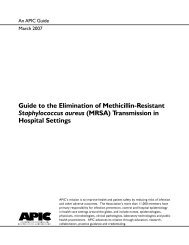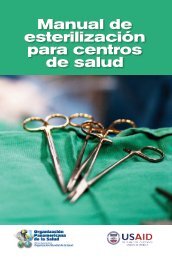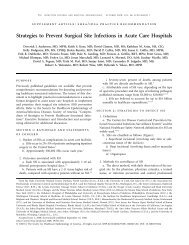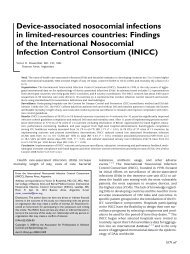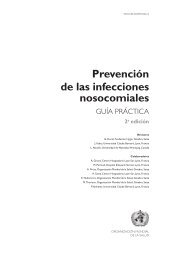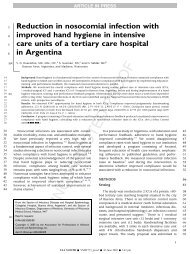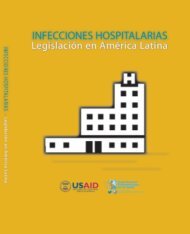Infection Control Guidelines - INICC
Infection Control Guidelines - INICC
Infection Control Guidelines - INICC
You also want an ePaper? Increase the reach of your titles
YUMPU automatically turns print PDFs into web optimized ePapers that Google loves.
Author's personal copy<br />
The Time-Dependent Bias and its Effect on Extra Length of<br />
Stay due to Nosocomial <strong>Infection</strong><br />
Adrian G. Barnett, PhD a, *, Jan Beyersmann, PhD b , Arthur Allignol, MSc b ,<br />
Victor D. Rosenthal, MD, MSc, CIC c , Nicholas Graves, PhD a , Martin Wolkewitz, PhD b<br />
a Queensland University of Technology, Brisbane, Australia<br />
b Freiburg Center for Data Analysis and Modeling, Freiburg, Germany<br />
c International Nosocomial <strong>Infection</strong> <strong>Control</strong> Consortium, Buenos Aires, Argentina<br />
Keywords:<br />
Cost<br />
Health-care decision makers<br />
Hospital<br />
Statistics<br />
A B S T R A C T<br />
Objectives: Many studies disregard the time dependence of nosocomial infection when<br />
examining length of hospital stay and the associated financial costs. This leads to the<br />
“time-dependent bias,” which biases multiplicative hazard ratios. We demonstrate the<br />
time-dependent bias on the additive scale of extra length of stay.<br />
Methods: To estimate the extra length of stay due to infection, we used a multistate model<br />
that accounted for the time of infection. For comparison we used a generalized linear model<br />
assuming a gamma distribution, a commonly used model that ignores the time of infection.<br />
We applied these two methods to a large prospective cohort of hospital admissions from<br />
Argentina, and compared the methods’ performance using a simulation study.<br />
Results: For the Argentina data the extra length of stay due to nosocomial infection was<br />
11.23 days when ignoring time dependence and only 1.35 days after accounting for the time<br />
of infection. The simulations showed that ignoring time dependence consistently overestimated<br />
the extra length of stay. This overestimation was similar for different rates of infection<br />
and even when an infection prolonged or shortened stay. We show examples where the timedependent<br />
bias remains unchanged for the true discharge hazard ratios, but the bias for the<br />
extra length of stay is doubled because length of stay depends on the infection hazard.<br />
Conclusions: Ignoring the timing of nosocomial infection gives estimates that greatly overestimate<br />
its effect on the extra length of hospital stay.<br />
Copyright © 2011, International Society for Pharmacoeconomics and Outcomes Research<br />
(ISPOR). Published by Elsevier Inc.<br />
Introduction<br />
Length of stay (LOS) in hospital is a key outcome when studying<br />
the health and economic impact of nosocomial infections<br />
(NIs) [1]. A patient with an NI is likely to stay longer in hospital,<br />
incurring extra cost. The cost arises because other patients are<br />
denied access to the hospital bed while it is used to treat the<br />
infected patient. There will be only small changes to financial<br />
expenditures from reducing NI because most are fixed within<br />
the cost structures of the hospital within the time frame of<br />
Funding: Martin Wolkewitz, Jan Beyersmann and Arthur Allignol were supported by Deutsche Forschungsgemeinschaft (FOR 534).<br />
Martin Wolkewitz’s visit to Brisbane was supported by the Institute of Health and Biomedical Innovation visiting researcher program.<br />
* Address correspondence to: Adrian G Barnett, Institute of Health and Biomedical Innovation, Queensland University of Technology, 60<br />
Musk Avenue, Kelvin Grove, Queensland, 4059, Australia.<br />
E-mail: a.barnett@qut.edu.au.<br />
1098-3015/$36.00 – see front matter Copyright © 2011, International Society for Pharmacoeconomics and Outcomes Research (ISPOR).<br />
Published by Elsevier Inc.<br />
doi:10.1016/j.jval.2010.09.008<br />
VALUE IN HEALTH 14 (2011) 381–386<br />
available at www.sciencedirect.com<br />
journal homepage: www.elsevier.com/locate/jval<br />
Time-dependent analysis of length of stay and<br />
mortality due to urinary tract infections in ten<br />
developing countries: <strong>INICC</strong> findings<br />
Victor D. Rosenthal a, *, Arpita Dwivedy b ,<br />
María Eugenia Rodríguez Calderon c , Saban Esen d ,<br />
Héctor Torres Hernandez e ,Rédouane Abouqal f , Eduardo A. Medeiros g ,<br />
Teodora Atencio Espinoza h , S.S. Kanj i , Achilleas Gikas j , Adrian G. Barnett k ,<br />
Nicholas Graves k , International Nosocomial <strong>Infection</strong> <strong>Control</strong> Consortium<br />
(<strong>INICC</strong>) Members l<br />
a International Nosocomial <strong>Infection</strong> <strong>Control</strong> Consortium, Buenos Aires, Argentina<br />
b Dr L H Hiranandani Hospital, Mumbai, India<br />
c Hospital La Victoria, Bogota, Colombia<br />
d Ondokuz Mayis University Medical School, Samsun, Turkey<br />
e Hospital General de Irapuato, Irapuato, Mexico<br />
f Ibn-Sina Hospital, Medical ICU, Rabat, Morocco<br />
g Hospital S~ao Paulo, S~ao Paulo, Brazil<br />
h Hospital Regional de Pucallpa, Pucallpa, Peru<br />
i American University of Beirut Medical Center, Beirut, Lebanon<br />
j University Hospital of Heraklion, Heraklion, Greece<br />
k School of Public Health, Queensland University of Technology, Brisbane, Australia<br />
Accepted 10 December 2010<br />
Available online 17 December 2010<br />
KEYWORDS<br />
International<br />
nosocomial infection<br />
control consortium;<br />
<strong>INICC</strong>;<br />
Urinary tract infections;<br />
Length of stay;<br />
Summary<br />
Objectives: To estimate the excess length of stay (LOS) and mortality in an intensive<br />
care unit (ICU) due to a Catheter associated urinary tract infections (CAUTI), using<br />
astatisticalmodelthataccountsforthetiming of infection in 29 ICUs from 10 countries:<br />
Argentina, Brazil, Colombia, Greece, India, Lebanon, Mexico, Morocco, Peru, and Turkey.<br />
Methods: To estimate the extra LOS due to infection in a cohort of 69,248 admissions followed for<br />
371,452 days in 29 ICUs, we used a multi-state model, including specific censoring to ensure that we<br />
estimate the independent effect of urinary tract infection, and not the combined effects of<br />
* Corresponding author. Ave #4580, Floor 12, Apt D, ZIP 1195, Buenos Aires, Argentina. Tel.: +54 11 4865 2585 (Office), +54 9 11 5691 1775<br />
(Mobile).<br />
E-mail address: victor_rosenthal@inicc.org (V.D. Rosenthal).<br />
l Refer Appendix section for International <strong>Infection</strong> <strong>Control</strong> Consortium, listed by country alphabetically.<br />
0163-4453/$36 ª 2011 The British <strong>Infection</strong> Association. Published by Elsevier Ltd. All rights reserved.<br />
doi:10.1016/j.jinf.2010.12.004<br />
www.elsevierhealth.com/journals/jinf<br />
Journal of <strong>Infection</strong> (2011) 62, 136e141<br />
Time-dependent analysis of extra length of stay and mortality<br />
due to ventilator-associated pneumonia in intensive-care units of<br />
ten limited-resources countries: findings of the International<br />
Nosocomial <strong>Infection</strong> <strong>Control</strong> Consortium (<strong>INICC</strong>)<br />
V. D. ROSENTHAL 1 *, F. E. UDWADIA 2 , H. J. MUN˜ OZ 3 , N. ERBEN 4 ,<br />
F. HIGUERA 5 , K. ABIDI 6 , E. A. MEDEIROS 7 , E. FERNÁNDEZ MALDONADO 8 ,<br />
S. S. KANJ 9 , A. GIKAS 10 , A. G. BARNETT 11 , N. GRAVES 11 and the International<br />
Nosocomial <strong>Infection</strong> <strong>Control</strong> Consortium (<strong>INICC</strong>)#<br />
1 International Nosocomial <strong>Infection</strong> <strong>Control</strong> Consortium, Buenos Aires, Argentina; 2 Breach Candy Hospital<br />
Trust, Mumbai, India; 3 Clıńica Reina Sofıá, Bogota´, Colombia; 4 Eskisehir Osmangazi University,<br />
Eskisehir, Turkey; 5 Hospital General de Me´xico, Mexico City, Mexico; 6 Ibn-Sina Hospital, Medical ICU,<br />
Rabat, Morocco; 7 Hospital Sa˜o Paulo, Sa˜o Paulo, Brazil; 8 Clıńica San Pablo, Lima, Peru;<br />
9 American University of Beirut Medical Center, Beirut, Lebanon; 10 University Hospital of Heraklion,<br />
Heraklion, Greece; 11 School of Public Health, Queensland University of Technology<br />
(Accepted 10 January 2011)<br />
SUMMARY<br />
Ventilator-associated pneumonias (VAPs) are a worldwide problem that significantly increases<br />
patient morbidity, mortality, and length of stay (LoS), and their effects should be estimated<br />
accounting for the timing of infection. The purpose of the study was to estimate extra LoS and<br />
mortality in an intensive-care unit (ICU) due to a VAP in a cohort of 69 248 admissions followed<br />
for 283 069 days in ICUs from 10 countries. Data were arranged according to the multi-state<br />
format. Extra LoS and increased risk of death were estimated independently in each country,<br />
and their results were combined using a random-effects meta-analysis. A VAP prolonged LoS<br />
by an average of 2 . 03 days (95% CI 1 . 52–2 . 54 days), and increased the risk of death by 14%<br />
(95% CI 2–27). The increased risk of death due to VAP was explained by confounding with<br />
patient morbidity.<br />
Key words: Bacterial infections, hospital-acquired (noscomial) infections, hygiene and hospital<br />
infections, pneumonia, surveillance.<br />
INTRODUCTION<br />
normally not be associated with the underlying<br />
Epidemiol. Infect., Page 1 of 7. f Cambridge University Press 2011<br />
doi:10.1017/S0950268811000094<br />
Device-associated infection rates in adult intensive care units of Cuban university<br />
hospitals: International Nosocomial <strong>Infection</strong> <strong>Control</strong> Consortium (<strong>INICC</strong>) findings<br />
H. Guanche-Garcell a , O. Requejo-Pino b , V.D. Rosenthal c, *, C. Morales-Pérez a ,<br />
O. Delgado-González b , D. Fernández-González b<br />
a Joaquín Albarrán Domínguez Surgical Training Hospital, Havana, Cuba<br />
b Gral. Calixto García University Hospital, Havana, Cuba<br />
c International Nosocomial <strong>Infection</strong> <strong>Control</strong> Consortium, Buenos Aires, Argentina<br />
International Journal of Infectious Diseases 15 (2011) e357–e362<br />
ARTICLE<br />
INFO<br />
Article history:<br />
Received 25 June 2010<br />
Received in revised form 20 December 2010<br />
Accepted 1 February 2011<br />
Corresponding Editor: Ziad Memish, Riyadh,<br />
Saudi Arabia<br />
Keywords:<br />
SUMMARY<br />
Objectives: To determine the rate of device-associated healthcare-associated infection (DA-HAI),<br />
microbiological profile, length of stay (LOS), extra mortality, and hand hygiene compliance in two<br />
intensive care units (ICUs) of two hospital members of the International <strong>Infection</strong> <strong>Control</strong> Consortium<br />
(<strong>INICC</strong>) of Havana, Cuba.<br />
Methods: An open label, prospective cohort, active DA-HAI surveillance study was conducted on adults<br />
admitted to two tertiary-care ICUs in Cuba from May 2006 to December 2009, implementing the<br />
methodology developed by <strong>INICC</strong>. Data collection was performed in the participating ICUs, and data<br />
were uploaded and analyzed at the <strong>INICC</strong> headquarters on proprietary software. DA-HAI rates were<br />
registered by applying the definitions of the US Centers for Disease <strong>Control</strong> and Prevention National<br />
Contents lists available at ScienceDirect<br />
International Journal of Infectious Diseases<br />
journal homepage: www.elsevier.com/locate/ijid<br />
Original Article<br />
Device-associated infection rates in intensive care units in El Salvador:<br />
International Nosocomial <strong>Infection</strong> <strong>Control</strong> Consortium (<strong>INICC</strong>) Findings<br />
Lourdes Dueñas 1 , Ana C. Bran de Casares 1 , Victor D. Rosenthal 2 , Lilian Jesús Machuca 1<br />
1 Hospital Nacional de Niños Benjamin Bloom, San Salvador, El Salvador<br />
2 International Nosocomial <strong>Infection</strong> <strong>Control</strong> Consortium, Buenos Aires, Argentina<br />
!<br />
Abstract<br />
Introduction: This study aimed to determine the rate of device-associated, health care-associated infection (DA-HAI), the excess in length of<br />
stay, the mortality, and the hand hygiene compliance in a pediatric intensive care unit (PICU) and a neonatal ICU (NICU) in a hospital<br />
member of the International <strong>Infection</strong> <strong>Control</strong> Consortium (<strong>INICC</strong>) in El Salvador.<br />
Methodology: A prospective cohort, active DA-HAI surveillance study was conducted on patients admitted in the pediatric and neonatal<br />
ICUs from January 2007 to November 2009. The protocol and methodology implemented were developed by <strong>INICC</strong>. Data were collected in<br />
the participating ICUs, and analyzed at <strong>INICC</strong> headquarters by proprietary software. DA-HAI rates were recorded by applying the definitions<br />
of the Centers for Disease <strong>Control</strong> and Prevention National Healthcare Safety Network.<br />
Results: Of 1,145 patients hospitalized in the PICU for 9,517 days, 177 acquired DA-HAIs (overall rate 15.5%), and 18.6 DA-HAIs per<br />
1,000 ICU-days. Furthermore, 1,270 patients hospitalized in the NICU for 30,663 days acquired 302 DA-HAIs (overall rate 23.8%), and 9.8<br />
Device-associated infections rates in<br />
adult, pediatric, and neonatal intensive<br />
care units of hospitals in the Philippines:<br />
International Nosocomial <strong>Infection</strong><br />
<strong>Control</strong> Consortium (<strong>INICC</strong>) findings<br />
Josephine Anne Navoa-Ng, MD, a Regina Berba, MD, b Yolanda Arreza Galapia, RN, c<br />
Victor Daniel Rosenthal, MD, CIC, MSc, d Victoria D. Villanueva, MD, a Marıa Corazon V. Tolentino, RN, a<br />
Glenn Angelo S. Genuino, MD, b Rafael J. Consunji, MD, b and Jacinto Blas V. Mantaring III, MD b<br />
Quezon City and Manila, Philippines; and Buenos Aires, Argentina<br />
Background: This study investigated the rate of device-associated health care–associated infection (DA-HAI), microbiological profiles,<br />
bacterial resistance, length of stay (LOS), and mortality rate in 9 intensive care units (ICUs) of 3 hospital members of the International<br />
Nosocomial <strong>Infection</strong> <strong>Control</strong> Consortium (<strong>INICC</strong>) in the Philippines.<br />
Methods: This was an open-label, prospective cohort, active DA-HAI surveillance study of adult, pediatric, and newborn patients<br />
admitted to 9 tertiary care ICUs in the Philippines between January 2005 and December 2009, implementing methodology developed<br />
by the <strong>INICC</strong>. Data collection was performed in the participating ICUs, and data were uploaded and analyzed at the <strong>INICC</strong><br />
headquarters using proprietary software. DA-HAI rates were registered based on definitions promulgated by the Centers for Disease<br />
<strong>Control</strong> and Prevention’s National Healthcare Safety Network.<br />
Results: Over a 5-year period, 4952 patients hospitalized in ICUs for a total of 40,733 days acquired 199 DA-HAIs, for an overall rate<br />
of 4.9 infections per 1,000 ICU-days. Ventilator-associated pneumonia posed the greatest risk (16.7 per 1,000 ventilator-days in the<br />
adult ICUs, 12.8 per 1,000 ventilator-days in the pediatric ICU, and 0.44 per 1,000 ventilator-days in the neonatal ICUs), followed by<br />
central line–associated bloodstream infections (4.6 per 1,000 catheter-days in the adult ICUs, 8.23 per 1,000 ventilator-days in the<br />
pediatric ICU, and 9.6 per 1,000 ventilator-days in the neonatal ICUs) and catheter-associated urinary tract infections (4.2 per<br />
1,000 catheter-days in the adult ICUs and 0.0 in the pediatric ICU).<br />
Conclusion: DA-HAIs pose far greater threats to patient safety in Philippine ICUs than in US ICUs. The establishment of active infection<br />
control programs that involve infection surveillance and implement guidelines for prevention can improve patient safety<br />
and should become a priority.<br />
Key Words: Nosocomial infection; hospital infection; health care–acquired infection; device associated infection; central line–<br />
associated bloodstream infection; ventilator-associated pneumonia; catheter-associated urinary tract infection; developing country;<br />
limited-resource country; infection control; surveillance; incidence density; length of stay; mortality; microorganism profile;<br />
bacterial resistance.<br />
Copyright ª 2011 by the Association for Professionals in <strong>Infection</strong> <strong>Control</strong> and Epidemiology, Inc. Published by Elsevier Inc. All rights<br />
reserved. (Am J Infect <strong>Control</strong> 2011;n:1-7.)<br />
In the United States as well as several other highincome<br />
countries, device-associated (DA) health care–<br />
associated infection (HAI) surveillance in the intensive<br />
care unit (ICU) plays an important role in hospital infection<br />
control and quality assurance. 1 Likewise, surveillance<br />
was reported by the Centers for Disease<br />
<strong>Control</strong> and Prevention’s (CDC) Study of the Efficacy<br />
of Nosocomial <strong>Infection</strong> <strong>Control</strong> as an efficacious tool<br />
to reduce DA-HAIs. 2<br />
In a growing body of literature, DA-HAIs are considered<br />
the principal threat to patient safety in the ICU<br />
and are among the main causes of patient morbidity<br />
and mortality. 3-5 The CDC’s National Nosocomial <strong>Infection</strong><br />
Surveillance System and National Healthcare<br />
Safety Network (NHSN) have promulgated standardized<br />
criteria for DA-HAI surveillance. 6,7 This standardized<br />
From St. Luke’s Medical Center, Quezon City, Philippines a ; Philippine<br />
General Hospital, Manila, Philippines b ; National Kidney and Transplant<br />
Institute, Quezon City, Philippines c ; and International Nosocomial <strong>Infection</strong><br />
<strong>Control</strong> Consortium, Buenos Aires, Argentina. d<br />
Address correspondence to Victor Daniel Rosenthal, MD, CIC, MSc, International<br />
Nosocomial <strong>Infection</strong> <strong>Control</strong> Consortium, Corrientes<br />
Ave, No. 4580, Floor 11, Apt A, Buenos Aires (1195), Argentina.<br />
E-mail: victor_rosenthal@inicc.org.<br />
Conflict of interest: None to report.<br />
0196-6553/$36.00<br />
Copyright ª 2011 by the Association for Professionals in <strong>Infection</strong><br />
<strong>Control</strong> and Epidemiology, Inc. Published by Elsevier Inc. All rights<br />
reserved.<br />
doi:10.1016/j.ajic.2010.10.018<br />
1<br />
Página 1 de 1<br />
http://www.ncbi.nlm.nih.gov/pubmed/21846591<br />
OBJECTIVES:<br />
METHODS:<br />
RESULTS:<br />
CONCLUSIONS:<br />
Display Settings:<br />
Abstract<br />
Int J Infect Dis. 2011 Aug 14. [Epub ahead of print]<br />
Device-associated infection rates in 398 intensive care units in Shanghai, China:<br />
International Nosocomial <strong>Infection</strong> <strong>Control</strong> Consortium (<strong>INICC</strong>) findings.<br />
Tao L, Hu B, Rosenthal VD, Gao X, He L.<br />
Department of Respiratory Medicine, Huadong Hospital, Fudan University, Shanghai, China.<br />
Abstract<br />
To determine device-associated healthcare-associated infection (DA-HAI) rates and the<br />
microorganism profile in 398 intensive care units (ICUs) of 70 hospitals in Shanghai, China.<br />
An open-label, prospective, cohort, active DA-HAI surveillance study was conducted on patients admitted<br />
to 398 tertiary-care ICUs in China from September 2004 to December 2009, implementing the methodology<br />
developed by the International Nosocomial <strong>Infection</strong> <strong>Control</strong> Consortium (<strong>INICC</strong>). The data were collected in the<br />
participating ICUs, and uploaded and analyzed at the <strong>INICC</strong> headquarters on proprietary software. DA-HAI rates were<br />
registered by applying the definitions of the US Centers for Disease <strong>Control</strong> and Prevention (CDC) National<br />
Healthcare Safety Network (NHSN). We analyzed the rates of DAI-HAI, ventilator-associated pneumonia (VAP),<br />
central line-associated bloodstream infection (CLABSI), and catheter-associated urinary tract infection (CAUTI), and<br />
their microorganism profiles.<br />
During the 5 years and 4 months of the study, 391 527 patients hospitalized in an ICU for an aggregate of<br />
3 245 244 days, acquired 20 866 DA-HAIs, an overall rate of 5.3% (95% confidence interval (CI) 5.3-5.4) and 6.4<br />
(95% CI 6.3-6.5) infections per 1000 ICU-days. VAP posed the greatest risk (20.8 per 1000 ventilator-days, 95% CI<br />
20.4-21.1), followed by CAUTI (6.4 per 1000 catheter-days, 95% CI 6.3-6.6) and CLABSI (3.1 per 1000 catheter-days,<br />
95% CI 3.0-3.2). The most common isolated microorganism was Acinetobacter baumannii (19.1%), followed by<br />
Pseudomonas aeruginosa (17.2%), Klebsiella pneumoniae (11.9%), and Staphylococcus aureus (11.9%).<br />
DA-HAIs in the ICUs of Shanghai pose a far greater threat to patient safety than in ICUs in the USA.<br />
This is particularly the case for the VAP rate, which is much higher than the rates found in developed countries. Active<br />
infection control programs that carry out infection surveillance and implement prevention guidelines can improve<br />
patient safety and must become a priority.<br />
Copyright © 2011 International Society for Infectious Diseases. Published by Elsevier Ltd. All rights reserved.<br />
PMID: 21846591 [PubMed - as supplied by publisher]<br />
PubMed<br />
LinkOut - more resources<br />
1<br />
Device-Associated <strong>Infection</strong>s Rate in an Intensive Care Unit of a Lebanese University<br />
Hospital: International Nosocomial <strong>Infection</strong> <strong>Control</strong> Consortium (<strong>INICC</strong>) Findings.<br />
Kanj SS 1 , Nada Zahreddine 1 , Rosenthal VD 2 , Nisreen Sidani 1 , Lamia Alamaddni Jurdi 1 , Zeina<br />
Kanafani 1 .<br />
1-American University of Beirut Medical Center, Beirut, Lebanon;<br />
2- International Nosocomial <strong>Infection</strong> <strong>Control</strong> Consortium, Buenos Aires, Argentina.<br />
Key words:<br />
Lebanon, intensive care unit, nosocomial infection, hospital infection, health care associated infection,<br />
device associated infection, central line associated blood stream infection, ventilator associated<br />
pneumonia, catheter associated urinary tract infection, surveillance, hand hygiene, international<br />
nosocomial infection control consortium, <strong>INICC</strong>.<br />
Device-associated infection rates and extra length of stay in<br />
an intensive care unit of a university hospital in Wroclaw,<br />
Poland: International Nosocomial <strong>Infection</strong> <strong>Control</strong><br />
Consortium's (<strong>INICC</strong>) findings<br />
Andrzej Kübler a , Wieslawa Duszynska a , Victor D Rosenthal b,⁎ , Malgorzata Fleischer a ,<br />
Teresa Kaiser a , Ewa Szewczyk a , Barbara Barteczko-Grajek a<br />
a Department of Anesthesiology and Intensive Therapy, Wroclaw Medical University, Wroclaw, Poland<br />
b International Nosocomial <strong>Infection</strong> <strong>Control</strong> Consortium, Buenos Aires, Argentina<br />
Keywords:<br />
Poland;<br />
Europe;<br />
Health care–associated<br />
infection;<br />
Hospital infections;<br />
Nosocomial infection;<br />
Central line–associated<br />
blood stream infection;<br />
Ventilator-associated<br />
pneumonia;<br />
Catheter-associated<br />
urinary tract infection;<br />
Intensive care unit;<br />
Length of stay<br />
Abstract<br />
Purpose: The aim of this study was to determine device-associated health care–associated infections<br />
(DA-HAI) rates, microbiologic profile, bacterial resistance, and length of stay in one intensive care unit (ICU)<br />
of a hospital member of the International Nosocomial <strong>Infection</strong> <strong>Control</strong> Consortium (<strong>INICC</strong>) in Poland.<br />
Materials and Methods: AprospectiveDA-HAIsurveillancestudywasconductedonanadultICUfrom<br />
January 2007 to May 2010. Data were collected by implementing the methodology developed by <strong>INICC</strong> and<br />
applying the definitions of DA-HAI provided by the National Healthcare Safety Network at the US Centers for<br />
Disease <strong>Control</strong> and Prevention.<br />
Results: Atotalof847patientshospitalizedfor9386daysacquired 206 DA-HAIs, an overall rate of 24.3%<br />
(95% confidence interval [CI], 21.5-27.4), and 21.9 (95% CI, 19.0-25.1) DA-HAIs per 1000 ICU-days.<br />
Central line–associated bloodstream infection rate was 4.01 (95% CI, 2.8-5.6) per 1000 catheter-days,<br />
ventilator-associated pneumonia rate was 18.2 (95% CI, 15.5-21.6) per 1000 ventilator-days, and catheterassociated<br />
urinary tract infection rate was 4.8 (95% CI, 3.5-6.5) per 1000 catheter-days. Length of stay was 6.9<br />
days for those patients without DA-HAI, 10.0 days for those with central line–associated bloodstream<br />
infection, 15.5 days for those with ventilator-associated pneumonia, and 15.0 for those with catheterassociated<br />
urinary tract infection.<br />
Conclusions: Most DA-HAI rates are lower in Poland than in <strong>INICC</strong>, but higher than in the National<br />
Healthcare Safety Network, expressing the feasibility of lowering infection rates and increasing patient safety.<br />
©2011ElsevierInc.Allrightsreserved.<br />
1. Introduction<br />
In most developed countries, including the United States, as<br />
well as several other high-income countries, the deviceassociated<br />
health care–associated infection (DA-HAI)<br />
⁎ Corresponding author. Corrientes Ave # 4580, Floor 11, Apt A, ZIP<br />
1195, Buenos Aires, Argentina.<br />
E-mail address: victor_rosenthal@inicc.org (V.D. Rosenthal).<br />
Website: www.inicc.org.<br />
0883-9441/$ – see front matter © 2011 Elsevier Inc. All rights reserved.<br />
doi:10.1016/j.jcrc.2011.05.018<br />
Journal of Critical Care (2011) xx, xxx–xxx<br />
Special communication<br />
International Nosocomial <strong>Infection</strong> <strong>Control</strong> Consortium (<strong>INICC</strong>) report,<br />
data summary of 36 countries, for 2004-2009<br />
Victor D. Rosenthal MD, MSc, CIC a, *, Hu Bijie MD b , Dennis G. Maki MD c , Yatin Mehta MD d ,<br />
Anucha Apisarnthanarak MD e , Eduardo A. Medeiros MD f , Hakan Leblebicioglu MD g , Dale Fisher MD h ,<br />
Carlos Álvarez-Moreno MD i , Ilham Abu Khader MD j , Marisela Del Rocío González Martínez MD k ,<br />
Luis E. Cuellar MD l , Josephine Anne Navoa-Ng MD m , Rédouane Abouqal MD n ,<br />
Humberto Guanche Garcell MD o , Zan Mitrev MD p , María Catalina Pirez García MD q , Asma Hamdi MD r ,<br />
Lourdes Dueñas MD s , Elsie Cancel MD t , Vaidotas Gurskis MD u , Ossama Rasslan MD v , Altaf Ahmed MD w ,<br />
Souha S. Kanj MD x , Olber Chavarría Ugalde RN y , Trudell Mapp RN z , Lul Raka MD aa ,<br />
Cheong Yuet Meng MD bb , Le Thi Anh Thu MD cc , Sameeh Ghazal MD dd , Achilleas Gikas MD ee ,<br />
Leonardo Pazmiño Narváez MD ff , Nepomuceno Mejía MD gg , Nassya Hadjieva MD hh ,<br />
May Osman Gamar Elanbya MD ii , María Eugenia Guzmán Siritt MD jj , Kushlani Jayatilleke MD kk<br />
a From the International Nosocomial <strong>Infection</strong> <strong>Control</strong> Consortium, Buenos Aires, Argentina<br />
b Zhongshan Hospital, Shanghai, China<br />
c University of Wisconsin Medical School, Madison, WI<br />
d Medanta the Medcity, New Delhi, India<br />
e Thammasat University Hospital, Pratumthani, Thailand<br />
f Hospital São Paulo, São Paulo, Brazil<br />
g Ondokuz Mayis University Medical School, Samsun, Turkey<br />
h National University Hospital, Singapore, Republic of Singapore<br />
i Hospital Universitario San Ignacio, Universidad Pontificia Javeriana, Bogotá, Colombia<br />
j Jordan University Hospital, Amman, Jordan<br />
k Instituto Mexicano del Seguro Social, Torreón, Mexico<br />
l Instituto Nacional de Enfermedades Neoplásicas (INEN), Lima, Peru<br />
m St. Luke’s Medical Center, Quezon City, Philippines<br />
n Ibn Sina Medical ICU, Rabat, Morocco<br />
o Hospital Docente Clínico Quirúrgico “Joaquín Albarrán Domínguez,” Havana, Cuba<br />
p Filip II Special Hospital for Surgery, Skopje, Macedonia<br />
q Centro Hospitalario Pereira Rosell Bouar, Montevideo, Uruguay<br />
r Hôpital d’Enfants, Tunis, Tunisia<br />
s Hospital Nacional de Niños Benjamin Bloom, San Salvador, El Salvador<br />
t San Jorge Children’s Hospital, Asociación Epidemiólogos de Puerto Rico, Guaynabo, Puerto Rico<br />
u Hospital of Kaunas University of Medicine, Kaunas, Lithuania<br />
v Ain Shams Faculty of Medicine, Cairo, Egypt<br />
w Liaquat National Hospital, Karachi, Pakistan<br />
x American University of Beirut Medical Center, Beirut, Lebanon<br />
y Hospital Hotel La Católica, San José, Costa Rica<br />
z Clínica Hospital San Fernando, Panama City, Panama<br />
aa National Institute for Public Health of Kosova and Medical School, Prishtina University, Prishtina, Kosovo<br />
bb Sunway Medical Centre Berhad and Monash University Sunway Campus, Petaling Jaya, Malaysia<br />
cc Cho Ray Hospital, Ho Chi Minh City, Vietnam<br />
dd King Fahad Medical City, Riyadh, Saudi Arabia<br />
ee University Hospital of Heraklion, Heraklion, Greece<br />
ff Hospital Eugenio Espejo, Quito, Ecuador<br />
gg Hospital General de la Plaza de la Salud, Santo Domingo, Dominican Republic<br />
hh University Hospital “Queen Giovanna-ISUL,” Sofia, Bulgaria<br />
ii Bahry Accident and Emergency Hospital, Khartoum, Sudan<br />
jj Hospital Militar Dr Carlos Arvelo, Caracas, Venezuela<br />
kk Sri Jayewardenepura General Hospital, Nugegoda, Sri Lanka<br />
* Address correspondence to Victor D. Rosenthal, MD, MSc, CIC, International<br />
Nosocomial <strong>Infection</strong> <strong>Control</strong> Consortium (<strong>INICC</strong>), Corrientes Ave 4580, Floor 11,<br />
Apt A, Buenos Aires 1195, Argentina.<br />
E-mail address: victor_rosenthal@inicc.org (V.D. Rosenthal).<br />
Victor D. Rosenthal and the Foundation to Fight Against Nosocomial <strong>Infection</strong>s<br />
funds all of the activities at <strong>INICC</strong> headquarters.<br />
Conflict of interest: None to report.<br />
Contents lists available at ScienceDirect<br />
American Journal of <strong>Infection</strong> <strong>Control</strong><br />
journal homepage: www.ajicjournal.org<br />
American Journal of<br />
<strong>Infection</strong> <strong>Control</strong><br />
0196-6553/$36.00 - Copyright Ó 2011 by the Association for Professionals in <strong>Infection</strong> <strong>Control</strong> and Epidemiology, Inc. Published by Elsevier Inc. All rights reserved.<br />
doi:10.1016/j.ajic.2011.05.020<br />
American Journal of <strong>Infection</strong> <strong>Control</strong> xxx (2011) 1-12<br />
5.1.0 DTD Š YMIC2159_proof Š 5 September 2011 Š 4:40 pm Š ce<br />
PROOF 1 infection control and hospital epidemiology january 2011, vol. 32, no. 1<br />
Thursday Nov 11 2010 12:37 PM/ICHE/v32n1/31587/MCORRADO<br />
original article<br />
Impact of Switching from an Open to a Closed Infusion System on<br />
Rates of Central Line–Associated Bloodstream <strong>Infection</strong>: A Meta-<br />
Analysis of Time-Sequence Cohort Studies in 4 Countries<br />
Dennis G. Maki, MD; Victor D. Rosenthal, MD, MSc, CIC; Reinaldo Salomao, MD; Fabio Franzetti, MD;<br />
Manuel Sigfrido Rangel-Frausto, MD<br />
background.<br />
We report a meta-analysis of 4 identical time-series cohort studies of the impact of switching from use of open infusion<br />
containers (glass bottle, burette, or semirigid plastic bottle) to closed infusion containers (fully collapsible plastic containers) on central<br />
line–associated bloodstream infection (CLABSI) rates and all-cause intensive care unit (ICU) mortality in 15 adult ICUs in Argentina,<br />
Brazil, Italy, and Mexico.<br />
methods.<br />
All ICUs used open infusion containers for 6–12 months, followed by switching to closed containers. Patient characteristics,<br />
adherence to infection control practices, CLABSI rates, and ICU mortality during the 2 periods were compared by x 2 test for each country,<br />
and the results were combined using meta-analysis.<br />
results.<br />
Similar numbers of patients participated in 2 periods (2,237 and 2,136). Patients in each period had comparable Average<br />
Severity of Illness Scores, risk factors for CLABSI, hand hygiene adherence, central line care, and mean duration of central line placement.<br />
CLABSI incidence dropped markedly in all 4 countries after switching from an open to a closed infusion container (pooled results, from<br />
10.1 to 3.3 CLABSIs per 1,000 central line–days; relative risk [RR], 0.33 [95% confidence interval {CI}, 0.24–0.46]; ). All-cause<br />
P ! .001<br />
ICU mortality also decreased significantly, from 22.0 to 16.9 deaths per 100 patients (RR, 0.77 [95% CI, 0.68–0.87]; ).<br />
P ! .001<br />
conclusions.<br />
Switching from an open to a closed infusion container resulted in a striking reduction in the overall CLABSI incidence<br />
and all-cause ICU mortality. Data suggest that open infusion containers are associated with a greatly increased risk of infusion-related<br />
bloodstream infection and increased ICU mortality that have been unrecognized. Furthermore, data suggest CLABSIs are associated with<br />
significant attributable mortality.<br />
Infect <strong>Control</strong> Hosp Epidemiol 2011; 32(1):000-000<br />
From the University of Wisconsin School of Medicine and Public Health, Madison (D.G.M.); Colegiales and Bernal Medical Centers, Buenos Aires,<br />
Argentina (V.D.R.); Santa Marcelina Hospital, Sao Paulo, Brazil (R.S.); Sacco Hospital, Milan, Italy (F.F.); and Specialties Instituto Mexicano del Seguro<br />
Social Hospital, Mexico City, Mexico (M.S.R.-F.).<br />
Received April 26, 2010; accepted July 7, 2010; electronically published November XX, 2010.<br />
2011 by The Society for Healthcare Epidemiology of America. All rights reserved. 0899-823X/2011/3201-00XX$15.00. DOI: 10.1086/657632<br />
Critically ill patients hospitalized in intensive care units<br />
(ICUs) commonly require central lines for administration of<br />
large volumes of parenteral fluids, blood products, intravenous<br />
medications such as pressors, and hemodynamic monitoring.<br />
The greatest iatrogenic threat to the safety of these<br />
patients is healthcare-associated infection, especially central<br />
line–associated bloodstream infection (CLABSI). 1,2<br />
There are 2 major sources of CLABSI: (1) colonization of<br />
the catheter, or catheter-related infection, and (2) contamination<br />
of the fluid administered through the device, or infusate-related<br />
infection. 3<br />
Contaminated infusate has been<br />
shown to be the cause of most epidemics of nosocomial<br />
bloodstream infection and has not been thought to be a common<br />
cause of endemic CLABSI. 4 Recent pathogenetic studies<br />
using molecular subtyping have shown that most CLABSIs<br />
with noncuffed and nontunneled short-term vascular catheters<br />
derive from microorganisms in the patient’s cutaneous<br />
microflora that gain access to the implanted device, colonize<br />
the external surface or lumen, most often during catheter<br />
insertion, and subsequently produce CLABSI. 5-8 All of these<br />
studies have been done in developed Western countries where<br />
closed infusion systems, consisting of nonvented, fully collapsible<br />
plastic fluid containers, are used exclusively.<br />
There are 2 types of intravenous fluid containers in use<br />
worldwide: a glass bottle, burette, or semirigid plastic bottle<br />
that must be externally vented to allow ambient air to enter<br />
for the fluid to egress (an open infusion container), and a<br />
fully collapsible plastic container that does not require external<br />
venting for the bag to empty (a closed infusion container).<br />
Open systems with rigid containers were used worldwide<br />
for more than 75 years until a nationwide outbreak of<br />
gram-negative bacteremia was traced to the intrinsically conq1<br />
q2<br />
q3<br />
186 www.thelancet.com Vol 377 January 15, 2011<br />
Health-care-associated infections in developing countries<br />
Health-care-associated infections in developing<br />
countries are a serious issue that is scarcely addressed in<br />
the scientific literature. Hence, the systematic review and<br />
meta-analysis in The Lancet by Benedetta Allegranzi and<br />
colleagues from WHO, which assessed the epidemiology<br />
of health-care-associated infections, is impressive. 1<br />
In this study, the investigators analysed pooled data<br />
from 220 selected publications from 1995 to 2008,<br />
including data from the Americas (22%), Europe (20%),<br />
southeast Asia (16%), the eastern Mediterranean (8%),<br />
Africa (5%), and other regions (29%). The prevalence<br />
of health-care-associated infections in developing<br />
pre-eclampsia and eclampsia. Studies have been done<br />
on calcium supplementation and low-dose aspirin as<br />
preventive measures in pregnancy, 8–10 but evidence<br />
on effectiveness and on which interventions can be<br />
delivered at various levels of the health system is<br />
not always clear. 8 The Collaborative E trial (Magpie)<br />
provided evidence that magnesium sulphate should<br />
be the treatment of choice for preventing eclamptic<br />
seizures or their recurrence, and should be used in<br />
preference to diazepam, phenytoin, and a lytic cocktail.<br />
The Magpie trial also showed that magnesium sulphate<br />
halves eclampsia risk after pre-eclampsia, and probably<br />
reduces the risk of maternal death. 11<br />
In addition to the limitations noted by the investigators,<br />
it is important to recognise that the PIERS<br />
prediction is only useful if the health system and the<br />
community in which the woman lives have appropriate<br />
and sufficient transportation and referral systems, and<br />
the capacity to administer drugs (magnesium sulphate,<br />
antihypertensive drugs), induce labour, and provide<br />
post partum care. We urge the maternal and neonatal<br />
health community to consider the study in the context<br />
of the large continuum of interventions that need<br />
to be in place. Recently, synergies and connections<br />
between the maternal and neonatal health fields have<br />
been emphasised. 12 Hypertension in pregnancy and<br />
pre-eclampsia challenge the public health community<br />
because of the need to simultaneously protect the<br />
mother and baby, and to balance sometimes competing<br />
needs to bring forward or delay the end of the pregnancy.<br />
This study focuses mainly on maternal outcomes but<br />
also has implications for neonatal health. Hypertension<br />
in pregnancy and pre-eclampsia are conditions that<br />
call for further collaboration between maternal and<br />
neonatal health experts.<br />
We applaud von Dadelszen and colleagues in their<br />
efforts to validate the fullPIERS model and thereby<br />
advance future treatments and interventions. We hope<br />
that this new knowledge will be translated into effective<br />
and immediate action and further adapted and validated<br />
for use in low-income and middle-income countries,<br />
and thus used to its greatest advantage to save the lives<br />
of mothers and babies.<br />
Katherine C Teela, Rebecca M Ferguson, France A Donnay,<br />
*Gary L Darmstadt<br />
Family Health Division, Global Health Program,<br />
Bill & Melinda Gates Foundation, Seattle, WA 98102, USA<br />
gary.darmstadt@gatesfoundation.org<br />
We declare that we have no conflicts of interest.<br />
1 Hogan MC, Foreman KJ, Naghavi M, et al. Maternal mortality for<br />
181 countries, 1980–2008: a systematic analysis of progress towards<br />
Millennium Development Goal 5. Lancet 2010; 375: 1609–23.<br />
2 Rajaratnam JK, Marcus JR, Flaxman AD, et al. Neonatal, postneonatal,<br />
childhood, and under-5 mortality for 187 countries, 1970–2010:<br />
a systematic analysis of progress towards Millennium Development Goal 4.<br />
Lancet 2010; 375: 1988–2008.<br />
3 Duley L. Maternal mortality associated with hypertensive disorders<br />
of pregnancy in Africa, Asia, Latin America and the Caribbean.<br />
Br J Obstet Gynaecol 1992; 99: 547–53.<br />
4 Jim B, Sharma S, Kebede T, Acharya A. Hypertension in pregnancy:<br />
a comprehensive update. Cardiol Rev 2010; 18: 178–89.<br />
5 Duley L. The global impact of pre-eclampsia and eclampsia. Semin Perinatol<br />
2009; 33: 130–37.<br />
6 Von Dadelszen P, Payne B, Li J, et al, for the PIERS Study Group. Prediction<br />
of adverse maternal outcomes in pre-eclampsia: development and<br />
validation of the fullPIERS model. Lancet 2010; published online Dec 24.<br />
DOI:10.1016/S0140-6736(10)61351-7.<br />
7 Danso KA, Opare-Addo HS. Challenges associated with hypertensive<br />
disease during pregnancy in low-income countries. Int J Gynaecol Obstet<br />
2010; 110: 78–81.<br />
8 Ronsmans C, Campbell O. Quantifying the fall in mortality associated<br />
with interventions related to hypertensive diseases of pregnancy.<br />
BMC Public Health (in press).<br />
9 Hofmeyr GJ, Atallah AN, Duley L. Calcium supplementation during<br />
pregnancy for preventing hypertensive disorders and related problems.<br />
Cochrane Database Syst Rev 2006; 3: CD1001059.<br />
10 Caritis S, Sibai B, Hauth J, et al, and the National Institute of Child Health<br />
and Human Development Network of Maternal-Fetal Medicine Units.<br />
Low-dose aspirin to prevent preeclampsia in women at high risk.<br />
N Engl J Med 1998; 338: 701–05.<br />
11 The Magpie Trial Collaborative Group. Do women with pre-eclampsia,<br />
and their babies, benefit from magnesium sulphate The Magpie Trial:<br />
a randomised placebo-controlled trial. Lancet 2002; 360: 1331–32.<br />
12 Bhutta ZA, Ali S, Cousens S, et al. Alma-Ata: Rebirth and Revision 6.<br />
Interventions to address maternal, newborn, and child survival: what<br />
difference can integrated primary health care strategies make<br />
Lancet 2008; 372: 972–89.<br />
Published Online<br />
December 10, 2010<br />
DOI:10.1016/S0140-<br />
6736(10)62005-3<br />
See Articles page 228<br />
CORRECTED PROOF<br />
CLINICAL AND EPIDEMIOLOGICAL STUDY<br />
1<br />
2 Socioeconomic impact on device-associated infections<br />
3 in limited-resource neonatal intensive care units:<br />
4 findings of the <strong>INICC</strong><br />
5 V. D. Rosenthal • P. Lynch • W. R. Jarvis • I. A. Khader • R. Richtmann • N. B. Jaballah •<br />
6 C. Aygun • W. V. Gómez • L. Dueñas • T. A. Espinoza • J. A. Navoa-Ng • M. Pawar •<br />
7 M. S. Oropeza • A. Barkat • N. Mejía • C. Y. Meng • A. Apisarnthanarak • <strong>INICC</strong> members<br />
8 Received: 30 September 2010 / Accepted: 9 June 2011<br />
9 Ó Springer-Verlag 2011<br />
10 Abstract<br />
11 Purpose To evaluate the impact of country socioeco-<br />
12 nomic status and hospital type on device-associated<br />
13 healthcare-associated infections (DA-HAIs) in neonatal<br />
14 intensive care units (NICUs).<br />
15 Methods Data were collected on DA-HAIs from Sep-<br />
16 tember 2003 to February 2010 on 13,251 patients in 30<br />
17<br />
NICUs in 15 countries. DA-HAIs were defined using cri-<br />
18<br />
teria formulated by the Centers for Disease <strong>Control</strong> and<br />
19<br />
Prevention. Country socioeconomic status was defined<br />
20<br />
using World Bank criteria.<br />
21<br />
Results Central-line-associated bloodstream infection<br />
22<br />
(CLA-BSI) rates in NICU patients were significantly lower<br />
23<br />
in private than academic hospitals (10.8 vs. 14.3 CLA-BSI<br />
24<br />
per 1,000 catheter-days; p \ 0.03), but not different in<br />
25<br />
public and academic hospitals (14.6 vs. 14.3 CLA-BSI per<br />
26<br />
1,000 catheter-days; p = 0.86). NICU patient CLA-BSI<br />
A1<br />
For a list of International Nosocomial <strong>Infection</strong> <strong>Control</strong> Consortium<br />
A2<br />
(<strong>INICC</strong>) members, see Appendix.<br />
A3<br />
V. D. Rosenthal (&)<br />
A4<br />
International Nosocomial <strong>Infection</strong> <strong>Control</strong> Consortium<br />
A5 (<strong>INICC</strong>), Corrientes Ave #4580, Floor 12, Apt D,<br />
A6<br />
1195 Buenos Aires, Argentina<br />
A7<br />
e-mail: victor_rosenthal@inicc.org<br />
A8<br />
P. Lynch<br />
A9<br />
Epidemiology Associates, Redmond, WA, USA<br />
A10<br />
W. R. Jarvis<br />
A11<br />
Jason and Jarvis Associates, LLC, Hilton Head Island, SC, USA<br />
A12<br />
I. A. Khader<br />
A13<br />
Jordan University Hospital, Amman, Jordan<br />
A14<br />
R. Richtmann<br />
A15<br />
Hospital e Maternidade Santa Joana, Sao Paulo, Brazil<br />
A16<br />
N. B. Jaballah<br />
A17<br />
Hôpital d’Enfants, Tunis, Tunisia<br />
A18<br />
C. Aygun<br />
A25<br />
T. A. Espinoza<br />
A26<br />
Hospital Regional de Pucallpa, Pucallpa, Peru<br />
A27<br />
J. A. Navoa-Ng<br />
A28<br />
St. Luke’s Medical Center, Quezon, Philippines<br />
A29<br />
M. Pawar<br />
A30<br />
Pushpanjali Crosslay Hospital, Ghaziabad, India<br />
A31<br />
M. S. Oropeza<br />
A32<br />
Hospital de la Mujer, Mexico, Mexico<br />
A33<br />
A. Barkat<br />
A34<br />
Children Hôspital of Rabat, Rabat, Morocco<br />
A35<br />
N. Mejía<br />
A36<br />
Hospital General de la Plaza de la Salud/Universidad<br />
A37<br />
Iberoamericana, Santo Domingo, Dominican Republic<br />
A38<br />
C. Y. Meng<br />
A39<br />
Sunway Medical Centre Berhad and Monash University Sunway<br />
A40<br />
Campus, Petaling Jaya, Selangar, Malaysia<br />
<strong>Infection</strong><br />
DOI 10.1007/s15010-011-0136-2<br />
Author Proof<br />
Major article<br />
Effectiveness of a multidimensional approach to reduce ventilator-associated<br />
pneumonia in pediatric intensive care units of 5 developing countries:<br />
International Nosocomial <strong>Infection</strong> <strong>Control</strong> Consortium findings<br />
Q1<br />
Victor D. Rosenthal a, *, Carlos Álvarez-Moreno b , Wilmer Villamil-Gómez c , Sanjeev Singh d ,<br />
Bala Ramachandran e , Josephine A. Navoa-Ng f , Lourdes Dueñas g , Ata N. Yalcin h , Gulden Ersoz i ,<br />
Antonio Menco c , Patrick Arrieta c , Ana C. Bran-de Casares g , Lilian de Jesus Machuca g ,<br />
Kavitha Radhakrishnan d , Victoria D. Villanueva f , Maria C.V. Tolentino f , Ozge Turhan h , Sevim Keskin h ,<br />
Eylul Gumus h , Oguz Dursun h , Ali Kaya i , Necdet Kuyucu i<br />
a International Nosocomial <strong>Infection</strong> <strong>Control</strong> Consortium, Buenos Aires, Argentina<br />
b Hospital Universitario San Ignacio, Universidad Pontificia Javeriana, Bogota, Colombia<br />
c Clinica Santa Maria, Sucre, Colombia<br />
d Amrita Institute of Medical Sciences and Research Center, Kochi, India<br />
e KK Childs Trust Hospital, Ghaziabad, India<br />
f St Luke’s Medical Center, Quezon City, Philippines<br />
g Hospital Nacional de Niños Benjamin Bloom, San Salvador, El Salvador<br />
h Akdeniz University, Antalya, Turkey<br />
i Faculty of Medicine, Mersin University, Mersin, Turkey<br />
Key Words:<br />
Hospital infection<br />
Background: Ventilator-associated pneumonia (VAP) is one of the most common health careeassociated<br />
Contents lists available at ScienceDirect<br />
American Journal of <strong>Infection</strong> <strong>Control</strong><br />
journal homepage: www.ajicjournal.org<br />
American Journal of<br />
<strong>Infection</strong> <strong>Control</strong><br />
American Journal of <strong>Infection</strong> <strong>Control</strong> xxx (2011) 1-5<br />
1<br />
2<br />
3<br />
4<br />
5<br />
6<br />
7<br />
8<br />
9<br />
10<br />
11<br />
12<br />
13<br />
14<br />
15<br />
16<br />
17<br />
18<br />
19<br />
20<br />
21<br />
22<br />
23<br />
24<br />
25<br />
26<br />
56<br />
57<br />
58<br />
59<br />
60<br />
61<br />
62<br />
63<br />
64<br />
65<br />
66<br />
67<br />
68<br />
69<br />
70<br />
71<br />
72<br />
73<br />
74<br />
75<br />
76<br />
77<br />
78<br />
79<br />
80<br />
81



